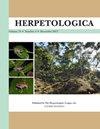英属维尔京群岛瓜纳岛波多黎各巨型地蜥的衰老和基于大小差异的生存
IF 1.1
3区 生物学
Q2 ZOOLOGY
引用次数: 0
摘要
摘要:入侵物种是岛屿上脊椎动物灭绝的主要威胁和主要驱动因素,包括本地和特有的蜥蜴,如西印度地蜥蜴(Pholidoscelis属)。该属包括19个现存物种,从巴哈马群岛到大安的列斯群岛南部,再到小安的列斯岛的多米尼克。尽管入侵哺乳动物与地蜥数量减少和三次灭绝有关,但很少有研究涉及地蜥种群生态学的各个方面。从2007年到2011年,我们在瓜纳岛对波多黎各巨型地蜥(Pholidoscelis exsul)进行了捕获-再捕获研究。瓜纳岛是私人所有的,有少量的野猫,但没有猫鼬,自18世纪中期以来,只经历过轻微的人类改造。因此,该岛为在受人类活动影响最小的条件下研究蜥蜴种群提供了一个独特的机会。我们的目标是建立exsul的基准人口统计学参数估计,可用于未来的研究,以检测生态变化。我们假设,由于可用的人为食物补贴,蜥蜴在受干扰的栖息地会比在受干扰较少的栖息地更频繁地遇到。我们还预测,大型蜥蜴的年生存率将高于小型蜥蜴,而身体状况指数较高的蜥蜴的年存活率将相应地高于身体状况指数较低的同类蜥蜴。我们的研究结果表明,男性的生长速度与类似的研究相当,个体在1年内达到了假定的性成熟程度,此后生长速度下降。年生存率随体型的增加而增加(小=0.155,95%置信区间[CI]=0.069–0.312;大=0.518,95%可信区间=0.374–0.660),但我们没有发现身体状况对年生存率有影响的证据。到6岁时,死亡率增加到99.4%,但身体状况下降导致衰老的证据更早显现。严重改良栖息地的日捕获概率(0.081,95%CI=0.049–0.132)高于相对自然的栖息地(0.025,95%CI=0.012–0.054)。捕获之间的平均最大移动距离为24.4米(2–350米)。每年的数量估计在139到250个个体之间。基于置信上限的各年密度估计值在核心采样区(6.01公顷)内为41.9–81.5人/公顷,在将12.5m缓冲带纳入有效采样区时为20.1–39.2人/公顷。本文章由计算机程序翻译,如有差异,请以英文原文为准。
Senescence and Differential Size-Based Survival in Puerto Rican Giant Groundlizards, Pholidoscelis exsul (Squamata: Teiidae), on Guana Island, British Virgin Islands
Abstract: Invasive species are a major threat and primary driver of vertebrate extinctions on islands, including native and endemic lizards such as West Indian Groundlizards (Genus Pholidoscelis). The genus comprises 19 extant species that range collectively from the Bahamas through the Greater Antilles south to Dominica in the Lesser Antilles. Few studies have addressed aspects of Groundlizard population ecology despite invasive mammals being implicated in Groundlizard declines and three extinctions. From 2007 to 2011, we conducted a capture–recapture study of Puerto Rican Giant Groundlizards (Pholidoscelis exsul) on Guana Island. Guana Island is privately owned and hosts a small number of feral cats, but is mongoose-free and has otherwise experienced only minor human modification since the mid-18th Century. Thus, the island provides a unique opportunity to study lizard demography under conditions minimally impacted by human activities. Our objective was to establish benchmark demographic parameter estimates of P. exsul that may be used in future studies to detect ecological changes. We hypothesized that lizards would be encountered more frequently in disturbed habitat than in less-disturbed habitat because of available anthropogenic food subsidies. We also predicted that large lizards would have higher annual survival rates than would small lizards, and lizards with higher indices of body condition would have correspondingly higher annual survival rates than lizards of the same size class with lower indices of body condition. Our results showed that male growth rates were comparable to similar studies, and individuals reached the presumed size of sexual maturity within 1 yr, with growth rates declining thereafter. Annual survival increased with size class (small = 0.155, 95% confidence interval [CI] = 0.069–0.312; large = 0.518, 95% CI = 0.374–0.660), but we found no evidence of a body condition effect on annual survival. The probability of mortality increased to 99.4% by age 6, but evidence of senescence via declining body condition was apparent sooner. Daily capture probabilities were higher in heavily modified habitat (0.081, 95% CI = 0.049–0.132) than in relatively natural habitat (0.025, 95% CI = 0.012–0.054). Mean maximum distance moved between recaptures was 24.4 m (2–350 m). Estimates of annual abundance ranged from 139 to 250 individuals. Density estimates among years based on the upper confidence limit ranged from 41.9–81.5 individuals/ha within the core sampling area (6.01 ha) and 20.1–39.2 individuals/ha when a 12.5-m buffer strip was incorporated into the effective sampling area.
求助全文
通过发布文献求助,成功后即可免费获取论文全文。
去求助
来源期刊

Herpetologica
生物-动物学
CiteScore
4.60
自引率
0.00%
发文量
27
审稿时长
>12 weeks
期刊介绍:
Established in 1936, Herpetologica is a quarterly peer-reviewed journal serving herpetologists, biologists, ecologists, conservationists, researchers and the scientific community. The journal contains original research papers and essays about the biology of reptiles and amphibians, and covers many relevant topics including: behavior, conservation, ecology, genetics, morphology, physiology and taxonomy.
 求助内容:
求助内容: 应助结果提醒方式:
应助结果提醒方式:


